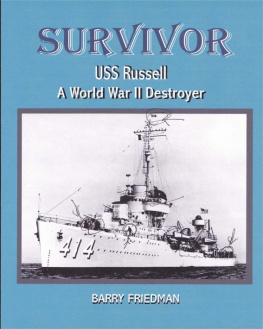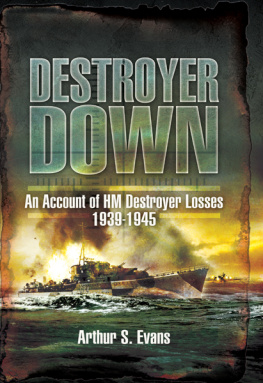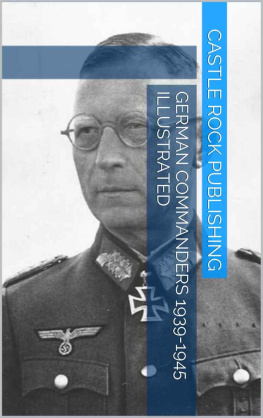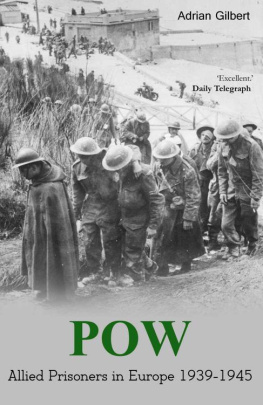TIN CAN SAILOR

The latest edition of this work has been brought to publication with the generous assistance of Marguerite and Gerry Lenfest.
Naval Institute Press
291 Wood Road
Annapolis, MD 21402
1993 by the U.S. Naval Institute, Annapolis, Maryland
All rights reserved. No part of this book may be reproduced or utilized in any form or by any means, electronic or mechanical, including photocopying and recording, or by any information storage and retrieval system, without permission in writing from the publisher.
First Bluejacket Books printing, 2000
ISBN 978-1-61251-567-0 (eBook)
The Library of Congress has cataloged the hardcover edition as follows:
Calhoun, C. Raymond, 1913-
Tin can sailor : life aboard the USS Sterett, 1939-1945 / C. Raymond Calhoun.
p. cm.
Includes index.
1. Calhoun, C. Raymond, 1913- 2. Sterett (Destroyer) 3. World War, 1939-1945Naval Operations, American. 4. World War, 1939-1945Personal Narratives, American. 5. World War, 19391945CampaignsPacific Area. 6. United States. NavyBiography. 7. SeamenUnited StatesBiography. I. Title.
D774.S74C35 1993
940.545973dc20
93-14743

 Print editions meet the requirements of ANSI/NISO z39.48-1992 (Permanence of Paper).
Print editions meet the requirements of ANSI/NISO z39.48-1992 (Permanence of Paper).
9 8 7 6 5 4
TO THOSE GALLANT SAILORS OF THE USS STERETT (DD 407) WHO GAVE THEIR LIVES DURING THE THIRD BATTLE OF SAVO ISLAND ON 13 NOVEMBER 1942.
CONTENTS
I N RETROSPECT, my years aboard the destroyer USS Sterett marked the most privileged period of my Navy career. The assignment occurred at a critical time, historically and personally. No other span of service proved to be as valuable in helping me to mature. It was exciting, inspirational, and gratifying.
As the war in the Pacific progressed, the Sterett never hesitated to wade in with flag flying and guns blazing to engage the enemy, whatever the odds. The ship was truly unique in many respects, and I will need some divine assistance to do justice to that uniqueness. It grew out of the personal and professional relationships that developed among her crew. I never encountered anything like it on any other ship.
A special bond existed among Sterett shipmates. The enlisted men got along well with each other, with the chiefs, and with the officers. The chiefs were outstanding, the backbone of the ship: veteran career men, experts in their specialties. They were blessed with self-assurance, and they maintained good relationships with both seniors and subordinates. The officers were close and compatible. They supported one another, did not vie for special treatment, were enthusiastic and dedicated, and looked upon the crew as friends and teammates. The prevailing atmosphere aboard the Sterett was one of mutual trust and respect. Comdr. J. D. Jeffrey, a former shipmate and a good friend, remarked in a recent letter that the ship itself was nothing but a thin-hulled shell housing a lot of metal parts, without the crew.... They, as much as the metal around them, were the Sterett. I agree with that comment but would add that the metal that surrounded us was exceptionally tough and had been expertly welded together.
While hospitalized in 194344 with a paralyzed right hand, I wrote a sketchy narrative about my experiences aboard the Sterett. It was a form of therapy for the wounded arm, but also a way of recording the story of the men who served on a gallant ship. I hoped to use it someday as the skeleton of a book. But the events of forty-odd years deferred the project until I attended the biannual Sterett reunion in 1987 in Bremerton, Washington. I wanted to discuss the idea of writing a book on our old ship with George Respess, a retired chief petty officer for whom I had always had great respect. To my sad surprise, I learned that Respess had passed away only a few weeks before the reunion. It was then apparent that the preparation of a narrative about the Sterett had to begin as soon as possible, before more shipmates moved on to their ultimate destinies. I was the after-dinner speaker at the reunion banquet that year, and my subject was the history of the Sterett. In concluding, I told those in attendance that if they would help by sending me firsthand accounts of the ships history after my detachment in April 1943, I would try to put together a book covering the Steretts entire life span. They assured me that they would cooperate, and I embarked on the effort that now reaches its end in these pages.
More than fifty Sterett veterans have contributed anecdotes and narrative accounts for this story. I have drawn on their letters freely, quoting from them when appropriate to present the events aboard the Sterett through the eyes of others. The letters, and countless personal conversations with the men of the Sterett at ships reunions and in their homes in Virginia Beach, Charleston, Myrtle Beach, Savannah, Suffolk, Glenwood, and Milford, provided details about life aboard the ship and confirmed the veracity of our reconstruction of events. Several personal diaries were made available, with their invaluable personal insights. It should come as no surprise that the resulting text is not uniform stylistically; but I hope that because it is based on such diverse sources, this story is not just a yarn spun by Cal Calhoun but rather a cross-section of the Steretts experience that more accurately reflects the attitudes and actions of those who served aboard her. It does not pretend to be a fully documented and precise history, although its authenticity has been reinforced by careful perusal of ships logs, action reports, and historical texts by many distinguished authors. This narrative is based on recollections, especially those of the principal author. I have transcribed conversations as I remember them, and except for minor changes in punctuation and deletions for the sake of brevity I have quoted the letters and diaries of my Sterett friends without alteration. Accordingly, I accept full responsibility for the general authenticity of the narrative. But any errors aside, this is an accurate first-person account of life aboard the Sterett from her commissioning in August 1939 until she was stricken from the Navy register in November 1945.
Much has been written about the Guadalcanal Campaign and the critical role played in it by U.S. naval forces. A common thread in all of these accounts is the issue of conflicting or unconfirmed claims of damage done to the enemy. This book cannot resolve this issue, but it does state the facts about the damage inflicted by the Sterett during the night action of 13 November 1942 as they appeared to those who were in the gun director and on the bridge. The account of the Third Battle of Savo Island presented in this book reflects countless personal conversations with the principal participants over the half-century since 13 November 1942. What is described here is what the captain, executive officer, gunnery officer, assistant gunnery officer, torpedo officer, assistant damage control officer, rangefinder operator, director trainer, bridge telephone talker, and chief gunners mate all agreed that they saw in the course of the battle. Their observations confirm that the Sterett damaged its Japanese battleship target in the bridge structure with some thirty-six 5-inch shell hits, and in the area of her engineering spaces with two torpedo hits. Our cruiser target was hit by forty-two 5-inch shells in the forecastle and forward gun mounts, and our destroyer target was hit by eight 5-inch shellfour in the bridge structure and four in the after gun mounts, which apparently detonated at the same time as two
Next page









